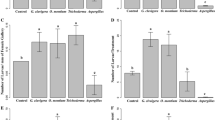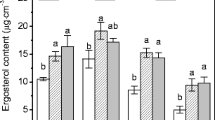Abstract
The mountain pine beetle, Dendroctonus ponderosae, depends on two fungi, Grosmannia clavigera and Ophiostoma montium, to augment a nutrient-poor woody food resource. Because the two fungi exert differential effects on the host beetle, temperature-driven differences in fungal growth and competition outcomes have a strong potential to influence host population dynamics. Weisolated fungi from beetles and wood from three locations in Montana and Utah, USA, and measured their growth rates and sporulation between 5 and 35 °C on artificial media. We also measured growth rates and percent resource capture for each fungus at 10, 15, 21, and 25 °C during inter- and intra-specific competition. G. clavigera excelled at resource capture at most temperatures. Its optimal growth temperature occurs around 20 °C while that of O. montium occurs near 30 °C. There was no effect of collection site on growth or sporulation; however, O. montium exhibited greater variability in response to temperature than did G. clavigera. Sporulation of G. clavigera was greatest at 30 °C while O. montium sporulated at low levels across all temperatures. During competition experiments, G. clavigera captured more resources than O. montium at most temperatures and captured a greater percentage of resources at a greater rate during inter-specific competition than during intra-specific competition. In contrast, O. montium captured a greater percentage of resources during intra-specific competition. These results demonstrate that temperature can differentially affect growth, sporulation, and resource capture of the two symbionts, indicating that it may be an important factor influencing the composition and dynamics of the symbiosis.




Similar content being viewed by others
References
Adams AS, Six DL (2007) Temporal variation in mycophagy and prevalence of fungi associated with developmental stages of the mountain pine beetle, Dendroctonus ponderosae (Coleoptera: Scolytinae, Curculionidae). Environ Entomol 26:64–72
Addison A, Bentz BJ, Friedman ML, Powell JA, Six DL (2013) The role of temperature variability in stabilizing the mountain pine beetle –fungus mutualism. J Theor Biol 335:40–50
Addison A, Powell, JA, Bentz BJ, Six DL (2015) Connecting predictions for fungal prevalence to temperature and mountain pine beetle development.J Theor Biol. In Press
Bentz BJ, Six DL (2006) Ergosterol content of three fungal species associated with Dendroctonus ponderosae and D. rufipennis (Coleoptera: Curculionidae, Scolytinae). Ann Entomol Soc Am 99:189–194
Bentz BJ, Logan JA, Amman GD (1991) Temperature-dependent development of the mountain pine beetle (Coleopteran: Scolytidae) and simulation of its phenology. Can Entomol 123:1083–1094
Bleiker KP, Six DL (2007) Dietary benefits of fungal associates to an eruptive herbivore: potential implications of multiple associates on host population dynamics. Environ Entomol 36:1384–1396
Bleiker KP, Six DL (2008) Competition and coexistence in a multipartner mutualism: interactions between two fungal symbionts of the mountain pine beetle in beetle attacked trees. Microb Ecol 57:191–202
Bleiker KP, Six DL (2008) Effects of water potential and solute on the growth and interactions of two fungal symbionts of the mountain pine beetle. Mycol Res 113:3–15
Bleiker KP, Potter SE, Lauzon CR, Six DL (2009) Transport of fungal symbionts by the mountain pine beetles. Can Entomol 141:503–514
Chesson P (2000) Mechanisms of maintenance of species diversity. Ann Rev Ecol Syst 31:343–366
Cook SS, Shirley BM, Zambino P (2010) Nitrogen concentration in mountain pine beetle larvae reflects nitrogen status of tree host and two fungal associates. Environ Entomol 39:821–821
Cunning R, Vaughan N, Gillette P, Capo TR, Mate JL, Baker AC (2014) Dynamic regulation of partner abundance mediatesresponse of reef coral symbiosis to environmental change. Ecology. doi:10.1890/14-0449.1
Doebeli M, Knowlton N (1998) The evolution of interspecific mutualisms. PNAS 95:8676–8680
Fan Y, Wernegreen JJ (2013) Can’t take the heat: high temperature depletes bacterial symbionts of ants. Microb Ecol 66:727–733
Goodsman DW, Erbilgin N, Lieffers VJ (2012) The impacts of phloem nutrients on overwintering mountain pine beetles and their fungal symbionts. Environ Entomol 41:478–486
Jenkins JL, Powell JA, Logan JA, Bentz BJ (2001) Low seasonal temperatures promote lifecycle synchronization. Bull Math Biol 63:573–595
Knezevic A (2008) StatNews # 73: Overlapping confidence intervals and statistical significance. Cornell University, Cornell Statistical Consulting Unit
Lee S, Kim JJ, Breuil C (2006) Diversity of fungi associated with the mountain pine beetle, Dendroctonus ponderosae and infested lodgepole pines in British Columbia. Fungal Divers 22:91–105
McGhehey JH (1971) Female size and egg production of the mountain pine beetle, Dendroctonus ponderosae Hopkins. Northern Forest Research Centre, Edmonton, Alberta, Publication NOR-X-9
Oliver KM, Degnan PH, Burke GR, Moran NA (2009) Facultative symbionts in aphids and the horizontal transfer of ecologically important traits. Ann Rev Ent 55:247–266
Osborne J (2002) Notes on the use of data transformations. Practical Assessment, Research and Evaluation, 8(6). http://PAREonline.net/getvn.asp?v=8andn=6
R version 3.0 (2013) R Core Development Team
Raffa KF, Berryman AA (1983) The role of host plant resistance in the colonization behavior and ecology of bark beetles (Coleoptera: Scolytidae). Ecol Monogr 53:27–49
Raffa KF, Aukema BH, Bentz BJ, Carrol AL, Hicke JA, Turner MG, Romme WH (2008) Cross-scale drivers of natural disturbance prone to anthropogenic amplification: the dynamics of mountain pine beetle eruptions. Bioscience 58:501–517
Rayner AD (1991) The challenge of the individualistic mycelium. Mycologia 83:48–71
Rice AV, Thormann MN, Langor DW (2008) Mountain pine beetle associated blue-stain fungi are differentially adapted to boreal temperatures. For Pathol 38:113–123
Roe AD, Rice AV, Coltman DW, Cooke JE (2011) Comparative phylogeography, genetic differentiation and contrasting reproductive modes in three fungal symbionts of a multi-partite bark beetle symbiosis. Mol Ecol 20:584–600
Safranyik L (1978) Effects of climate and weather on mountain pine beetle populations. Pages 79-86 in D.L. Kibbee, A.A. Berryman, G.D. Amman, and R.W. Stark, eds. Theory and practice of mountain pine beetle management in lodgepole pine forests. Symp. Proc.,Univ. Idaho, Moscow, ID
Safranyik L, Carroll A (2006) The biology and epidemiology of the mountain pine beetle in lodgepole pine forests. Pp. 3-66, In Safranyik L. and Wilson B. (eds.) The mountain pine beetle: a synthesis of its biology and management and impacts on lodgepole pine. Natural Resources Canada, Canadian Forest Service
Safranyik L, Carrol AL, Regniere J, Langor DW, Reil WG, Shore TL, Peter B, Booke BJ, Nealis VG, Taylor SW (2010) Potential for range expansion of mountain pine beetle into the boreal forests of North America. Can Entomol 142:415–441
Six DL (2012) Ecological determinants of bark beetle-fungus symbiosis. Insects 3:339–366
Six DL, Paine TD (1997) Ophiostoma clavigerumis the mycangial fungus of the Jeffrey pine beetle, Dendroctonus jeffreyi. Mycologia 89:858–866
Six DL, Paine TD (1998) Effects of mycangial fungi and host tree species on progeny survival and emergence of Dendroctonus ponderosae (Coleoptera: Scolytidae). Environ Entomol 27:1393–1401
Six DL, Paine TD (1999) Phylogenetic comparison of ascomycete fungi and Dendroctonus bark beetles (Coleoptera: Scolytidae). Ann Entomol Soc Am 92:159–166
Six DL, Bentz BJ (2007) Temperature determines symbiont abundance in a multi-partite bark beetle-fungus symbiosis. Microb Ecol 54:112–118
Solheim H (1995) Early stages of blue-stain fungus invasion of lodgepole pine sapwood following mountain pine beetle attack. Can J Bot 73:70–74
Solheim H, Krokene P (1998) Growth and virulence of mountain pine beetle associated blue stain fungi, Ophiostoma clavigerum and Ophiostoma montium. Can J Bot 76:561–566
Whitney HS, Farris SH (1970) Maxillary mycangium in the mountain pine beetle. Science 167:54–55
Acknowledgments
We thank David Affleck and Brian Steele for assistance with data analysis and Audrey Addison, Barbara Bentz, Jim Powell, Cory Cleveland, John McCutcheon, Caleb Craft, Joseph Caleb Dysthe, Pamela Erm, Brenna Hannapel, Dara McDevitt, Emily Newman, Austin Stewart, and Aspen Ward for general assistance. This work was supported by National Science Foundation grant DEB 0918756 to Diana L. Six. The authors declare that they have no conflict of interest.
Author information
Authors and Affiliations
Corresponding author
Rights and permissions
About this article
Cite this article
Moore, M.L., Six, D.L. Effects of Temperature on Growth, Sporulation, and Competition of Mountain Pine Beetle Fungal Symbionts. Microb Ecol 70, 336–347 (2015). https://doi.org/10.1007/s00248-015-0593-8
Received:
Accepted:
Published:
Issue Date:
DOI: https://doi.org/10.1007/s00248-015-0593-8




